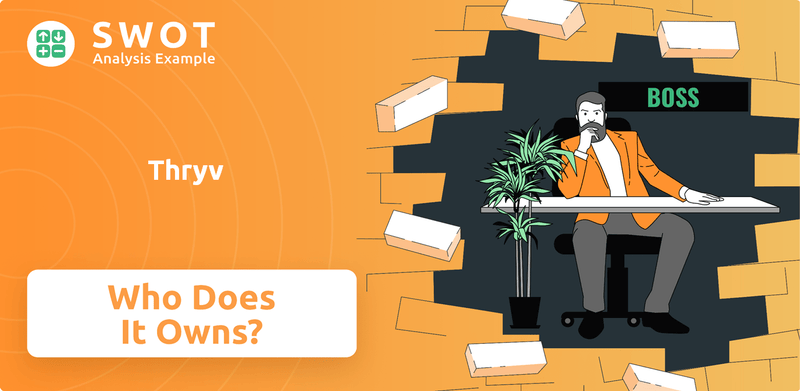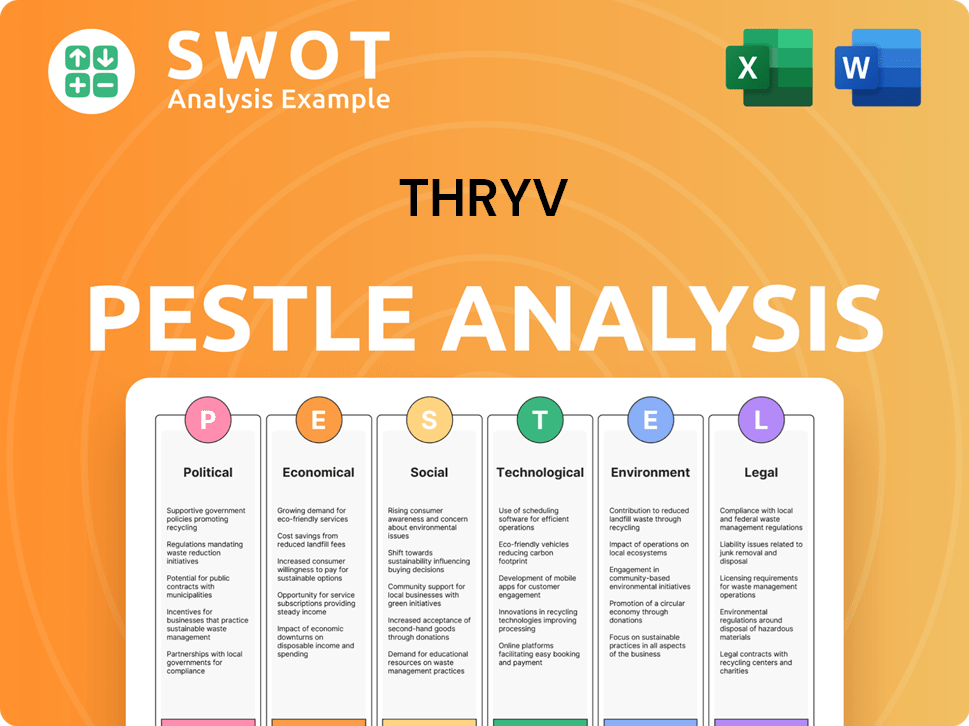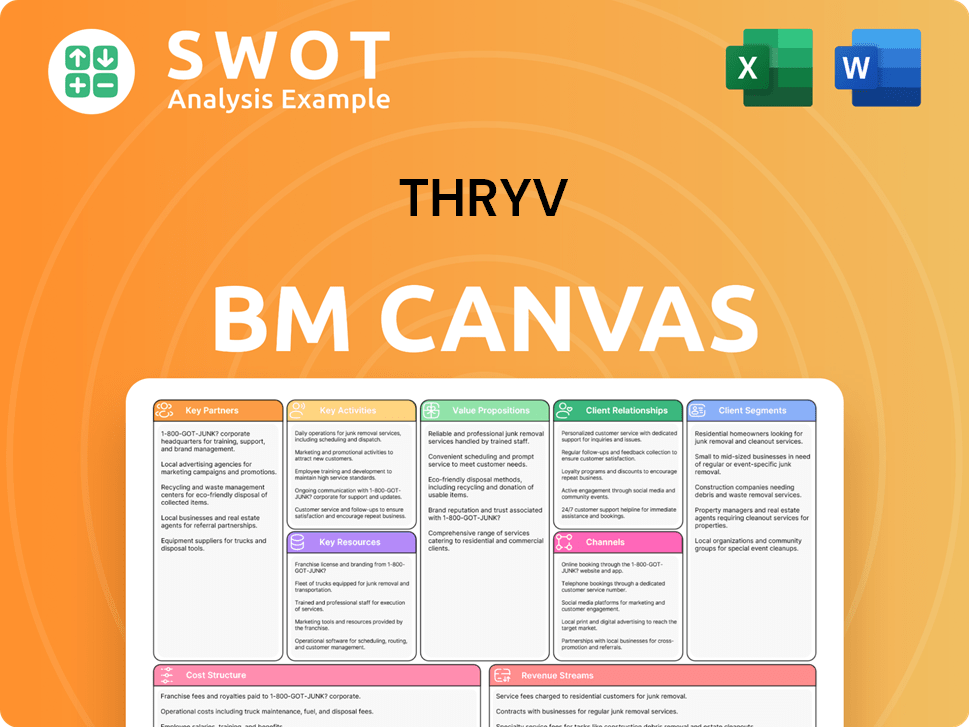Thryv Bundle
Who Really Owns Thryv Company?
Thryv Holdings, Inc. (NASDAQ: THRY) has evolved significantly since its inception, transforming from a print directory legacy to a SaaS powerhouse. This shift, driven by its flagship software, has reshaped the company's focus on empowering small businesses. Understanding the Thryv SWOT Analysis is key to grasping its strategic positioning and future prospects.

This exploration of "Who owns Thryv" will delve into the company's ownership structure, examining the influence of its founders, key investors, and the impact of being a publicly traded entity. We'll uncover the dynamics behind Thryv Inc's strategic decisions and how its ownership has influenced its growth and market position. Furthermore, we will analyze the Thryv parent company and its subsidiaries, if any, to provide a comprehensive overview of this evolving business.
Who Founded Thryv?
The story of Thryv, or Thryv Inc, begins with the merger of Dex Media and YP Holdings in 2017. This merger marked the genesis of the company, with roots deeply embedded in the traditional yellow pages publishing sector. The transformation from its legacy roots to a SaaS-focused entity is a key part of understanding Thryv's evolution and current ownership structure.
The shift towards a software-centric business model was significantly influenced by the leadership of Joe Walsh, who served as Chairman and CEO. The rebranding in July 2019 further solidified this strategic pivot. The early ownership structure involved the stakeholders from the Dex Media restructuring in 2016 and the subsequent merger, which set the stage for the company's future trajectory.
The company's entry into the public market occurred on October 1, 2020, through a direct listing on NASDAQ. This approach, different from a traditional IPO, provided a unique pathway for Thryv to become a publicly traded company. At the time of its public debut, the company had a market capitalization of approximately $430 million.
Understanding Thryv ownership involves tracing its origins back to the merger of Dex Media and YP Holdings. Joe Walsh, as CEO, played a crucial role in the company's transition towards a SaaS model. The initial public offering was a direct listing on NASDAQ.
- Thryv emerged from the 2017 merger of Dex Media and YP Holdings.
- The company's focus shifted to a SaaS platform under CEO Joe Walsh.
- Thryv went public via a direct listing on October 1, 2020.
- At its public debut, the company's market cap was around $430 million.
Thryv SWOT Analysis
- Complete SWOT Breakdown
- Fully Customizable
- Editable in Excel & Word
- Professional Formatting
- Investor-Ready Format

How Has Thryv’s Ownership Changed Over Time?
The evolution of Thryv's ownership structure is marked by key events, starting with its direct listing on NASDAQ on October 1, 2020. As of June 13, 2025, the company's market capitalization stood at $561.60 million. This transition to public trading has significantly influenced the company's financial dynamics and investor base, shaping its strategic direction and growth trajectory. Understanding the Thryv ownership is crucial for investors and stakeholders alike.
Strategic acquisitions have also played a pivotal role in shaping the Thryv company's ownership. The acquisition of Sensis in March 2021 expanded its reach, and the more recent acquisition of Keap in October 2024 further solidified its position in the SaaS market. This acquisition was partly financed through a public offering of 5,715,000 shares at $14.00 per share, raising approximately $80.0 million. These actions illustrate Thryv Inc's commitment to expanding its SaaS offerings and global footprint.
| Metric | Value | Date |
|---|---|---|
| Market Capitalization | $561.60 million | June 13, 2025 |
| Total Revenue (2024) | $824.2 million | December 31, 2024 |
| SaaS Revenue (2024) | $343.5 million | December 31, 2024 |
| Net Loss (2024) | $74.2 million | December 31, 2024 |
As of May 2025, institutional investors held 110.48% of the shares, with mutual funds holding 67.24%. Major institutional shareholders include BlackRock, Inc., FMR LLC, and Vanguard Group Inc. These figures highlight the significant institutional interest in Thryv stock. To learn more about Thryv's strategic direction, check out the Growth Strategy of Thryv. The company's financial performance, as of December 31, 2024, shows total revenue of $824.2 million, with SaaS revenue at $343.5 million, a 30.2% increase from the previous year. The consolidated net loss for 2024 was $74.2 million, reflecting the ongoing transition and investments in its SaaS business model.
Thryv ownership is primarily held by institutional investors and mutual funds.
- The company went public via a direct listing in October 2020.
- Strategic acquisitions, such as Sensis and Keap, have expanded its reach and offerings.
- Financial performance in 2024 shows strong SaaS revenue growth.
- Understanding the Thryv parent company and its stakeholders is essential for investors.
Thryv PESTLE Analysis
- Covers All 6 PESTLE Categories
- No Research Needed – Save Hours of Work
- Built by Experts, Trusted by Consultants
- Instant Download, Ready to Use
- 100% Editable, Fully Customizable

Who Sits on Thryv’s Board?
The Board of Directors of the Thryv company, as of February 2025, consists of eight members, with a majority classified as independent directors, adhering to Nasdaq Listing Rules. The board periodically assesses its size and composition. The company's articles of incorporation allow the Board to determine the number of directors, with a minimum requirement of one.
Understanding the Thryv target market is crucial when assessing the company's trajectory and ownership dynamics. The board's structure and the distribution of voting power are key factors influencing the company's strategic direction and operational decisions.
| Board Member | Title | Affiliation |
|---|---|---|
| Joe Walsh | Chairman of the Board | Mudrick Capital Management, L.P. |
| Paul B. Zuber | Chief Executive Officer | Thryv Holdings, Inc. |
| Grant D. Johnson | Director | Independent |
| David J. Brown | Director | Independent |
| Steven J. Kam | Director | Independent |
| Mark A. Roberts | Director | Independent |
| Laura A. Thomas | Director | Independent |
| Paul A. Zuber | Director | Independent |
Each share of Thryv common stock grants one vote on all matters presented at the Annual Meeting. The company does not employ cumulative voting for director elections. As of April 17, 2023, there were 34,821,268 shares of common stock outstanding and eligible to vote. In May 2021, Mudrick Capital Management, L.P. and Joe Walsh, holding approximately 55.3% of the common stock, approved an amendment to the Thryv Holdings, Inc. 2020 Incentive Award Plan by written consent, demonstrating significant voting influence. The Board has the authority to issue preferred stock, which could affect voting power and potentially influence control changes.
The Thryv ownership structure, including the board's composition and voting rights, is essential for investors and stakeholders. Understanding who owns Thryv and the distribution of voting power provides insights into the company's strategic decisions and potential changes.
- Independent directors make up the majority of the board.
- Each share of common stock equals one vote.
- Significant voting power was held by Mudrick Capital Management, L.P. and Joe Walsh.
- The Board can issue preferred stock, which could impact voting power.
Thryv Business Model Canvas
- Complete 9-Block Business Model Canvas
- Effortlessly Communicate Your Business Strategy
- Investor-Ready BMC Format
- 100% Editable and Customizable
- Clear and Structured Layout

What Recent Changes Have Shaped Thryv’s Ownership Landscape?
Over the past few years, Thryv's ownership structure and strategic direction have undergone notable shifts. The company, which is publicly traded, has been actively transitioning from a traditional marketing services provider to a SaaS-driven business model. A key development in this transition was the acquisition of Keap in the fall of 2024, which broadened its suite of marketing automation and sales solutions. This move, combined with a public offering in October 2024 that raised approximately $80.0 million, indicates a focus on growth and expansion within the SaaS sector.
In May 2024, Thryv announced a stock repurchase program, authorizing the buyback of up to $40 million of its outstanding common stock, valid until April 2029. As of March 31, 2025, the company had repurchased 26,495 shares for $0.5 million under this program. This reflects a strategy to manage its capital and potentially increase shareholder value. Furthermore, the company has seen changes in leadership, including the departure of the Chief Revenue Officer in early 2025, and the appointment of new sales leadership, signaling adjustments in its operational structure.
Institutional ownership of Thryv stock is significant, with institutional investors holding 110.48% and mutual funds holding 67.24% of the shares as of May 2025. Despite a decline in revenue from its legacy marketing services, Thryv's SaaS revenue grew by 30.2% in 2024, reaching $343.5 million. The company projects continued growth in SaaS revenue, aiming for 18%-20% organic growth in 2025 and targeting for SaaS revenue to constitute over 50% of its consolidated revenues by 2025. The company plans to exit its Marketing Services solutions by the end of 2028.
| Metric | Value | Year |
|---|---|---|
| SaaS Revenue Growth | 30.2% | 2024 |
| SaaS Revenue | $343.5 million | 2024 |
| Projected Organic SaaS Revenue Growth | 18%-20% | 2025 |
| Shares Repurchased | 26,495 | As of March 31, 2025 |
| Stock Repurchase Program Authorization | $40 million | May 2024 |
Thryv is a publicly traded company, with ownership distributed among institutional investors and mutual funds.
The company's stock performance is influenced by its transition to a SaaS model and strategic acquisitions.
The company is focused on growing its SaaS revenue and expanding its market presence.
Thryv anticipates SaaS EBITDA to be the majority of Consolidated EBITDA in 2026 and plans to exit its Marketing Services solutions by the end of 2028.
Thryv Porter's Five Forces Analysis
- Covers All 5 Competitive Forces in Detail
- Structured for Consultants, Students, and Founders
- 100% Editable in Microsoft Word & Excel
- Instant Digital Download – Use Immediately
- Compatible with Mac & PC – Fully Unlocked

Related Blogs
- What are Mission Vision & Core Values of Thryv Company?
- What is Competitive Landscape of Thryv Company?
- What is Growth Strategy and Future Prospects of Thryv Company?
- How Does Thryv Company Work?
- What is Sales and Marketing Strategy of Thryv Company?
- What is Brief History of Thryv Company?
- What is Customer Demographics and Target Market of Thryv Company?
Disclaimer
All information, articles, and product details provided on this website are for general informational and educational purposes only. We do not claim any ownership over, nor do we intend to infringe upon, any trademarks, copyrights, logos, brand names, or other intellectual property mentioned or depicted on this site. Such intellectual property remains the property of its respective owners, and any references here are made solely for identification or informational purposes, without implying any affiliation, endorsement, or partnership.
We make no representations or warranties, express or implied, regarding the accuracy, completeness, or suitability of any content or products presented. Nothing on this website should be construed as legal, tax, investment, financial, medical, or other professional advice. In addition, no part of this site—including articles or product references—constitutes a solicitation, recommendation, endorsement, advertisement, or offer to buy or sell any securities, franchises, or other financial instruments, particularly in jurisdictions where such activity would be unlawful.
All content is of a general nature and may not address the specific circumstances of any individual or entity. It is not a substitute for professional advice or services. Any actions you take based on the information provided here are strictly at your own risk. You accept full responsibility for any decisions or outcomes arising from your use of this website and agree to release us from any liability in connection with your use of, or reliance upon, the content or products found herein.